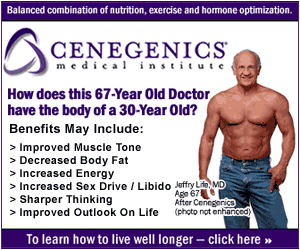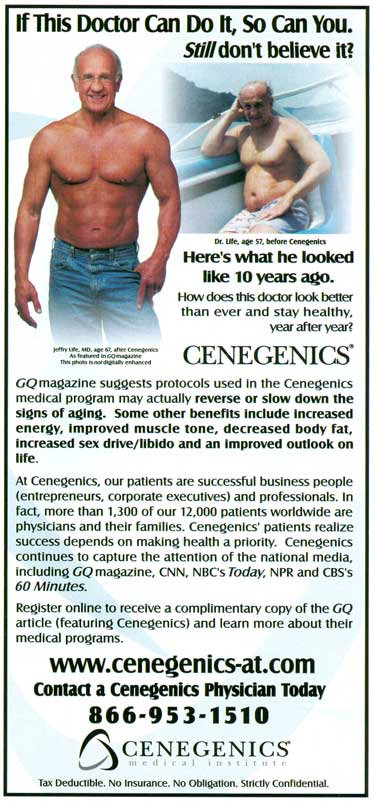A recent ad campaign by Cenegenics Medical Institute seen in various domestic in-flight magazines and on various websites featured the muscular torso of Dr. Jeffry Life, Chief Medical Officer of Cenegenics Las Vegas. One internet banner ad asks the question, “how does this 67-year old doctor have the body of a 30-year old?”

The answer, in part, is likely anabolic steroids (testosterone) and human growth hormone which are the cornerstone of anti-aging and age management medicine. The Cenegenics ad campaign seeks to appeal to individuals seeking to improve their physical appearance; benefits may include “improved muscle tone,” “decreased body fat,” “increased energy,” “increased sex drive / libido,” “sharper thinking,” and “improved outlook on life.” These happen to be the same motivations that lead men of all ages to the illicit use anabolic steroids and growth hormone.
When I attended a lecture by Dr. Bob Goldman, American Academy of Anti-Aging Medicine (A4M), at the 2008 Iron Man Expo in Los Angeles, I was surprised that the presentation focused primarily on the obtainability of muscular, athletic physiques through the anti-aging lifestyle with a slideshow featuring several muscular bodybuilders and athletes.
With all the negative news about steroids in baseball and steroid pharmacy scandals, should age management (Cenegenics) and anti-aging organizations (A4M) aggressively market the muscle-building and bodybuilding effects of anabolic steroids (testosterone) and growth hormone (i.e. hormone optimization) to prospective clients? (“Mainstream docs join the anti-aging bandwagon,” April 21)
Now that sports doping scandals have made HGH, as well as testosterone and other hormones, front-page news, and some anti-aging clinics and compounding pharmacies have been raided by the U.S. Drug Enforcement Agency for being overly liberal with hormone prescriptions, the anti-aging community has toned down its endorsement of hormones, at least in public.
Less than 10 percent of patients involved in anti-aging are receiving growth hormone, Klatz insists.
That seems a dubious assertion. In fact, hormones remain a key ingredient of anti-aging practice. Most of my anti-aging patients get hormones, typically growth hormone as well as sex hormones appropriate to each gender, Jurow says.
Given the steroid hysteria and steroid demonization resulting from the steroids in sports scandals, it seems like this would hurt business for anti-aging medicine. But this has not been the case, business is booming in anti-aging medicine.
Back in 1994, the annual Las Vegas meeting of the fledgling American Academy of Anti-Aging Medicine (A4M) was held in a small hotel off the Las Vegas strip. Everyone could fit into a temporary tent-like structure on the pool patio. Last December, at the 15th A4M confab, roughly 2,000 attendees, including business owners, anti-aging promoters and hundreds of doctors ” among them obstetricians, ER docs, psychiatrists and internists ” filled a cavernous meeting space inside the Venetian Hotel and Resort.
Today, claims Dr. Bob Goldman, A4M’s co-founder, there are about 20,000 A4M-certified doctors around the world. A4M’s tax returns confirm the boom. The income from fees charged to those seeking board certification from A4M more than doubled from $544,845 in 2005 to $1.2 million in 2006.
A rival organization, Age Management Medicine Group, is growing rapidly, too, says co-founder Rick Merner. He claims the group had more than 400 doctors at its last meeting, sponsored by the nation’s single largest age-management clinic, Cenegenics. The Cenegenics Foundation also certifies practitioners in age-management medicine (it shuns the term anti-aging) and claims to have experienced a 100 percent increase in the number of its physician affiliates to more than 800.
Could the steroid hysteria actually be stimulating business for legal prescriptions for testosterone and growth hormone?! The public condemnation of the muscle-building and performance-enhancing effects of steroids and other PEDs may be accompanied by a private celebration of the potential benefits of these hormones.

About the author
Millard writes about anabolic steroids and performance enhancing drugs and their use and impact in sport and society. He discusses the medical and non-medical uses of anabolic-androgenic steroids while advocating a harm reduction approach to steroid education.

2 replies
Loading new replies...
Join the full discussion at the MESO-Rx →